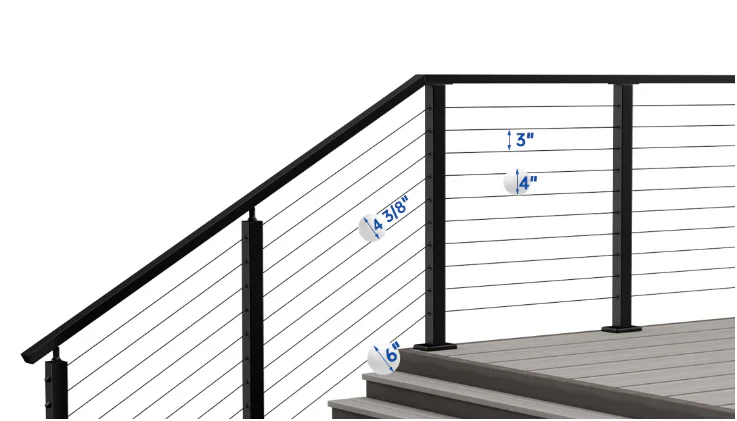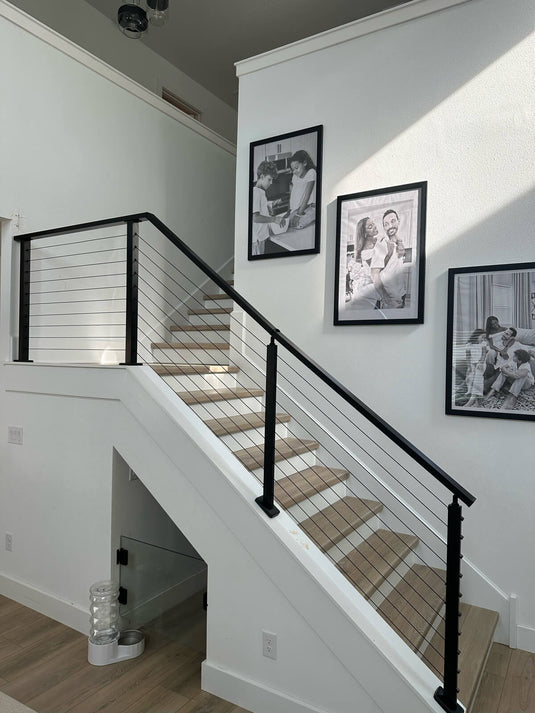TABLE OF CONTENTS
Cable Railing Code and Guardrail Requirements Guides
Cable railings are currently a craze among homeowners and builders alike who desire a minimalist, sleek look without the visual intrusion of conventional railings. They give you that silky, almost imperceptible screen that conventional railings cannot match. But, before you join this bandwagon, keep in mind that these systems come with a set of rules and regulations that accompany them. Safety comes first, and that's where the Cable Railing Code steps in.

So, What Exactly Are We Talking About?
Essentially, a cable railing system is horizontal or sometimes vertical stainless steel cables running between posts. Posts may be wood, metal, or composite. They're used for their transparency to permit light and views to pass through, opening spaces to make them appear larger and feel more connected to the world around them. It's an upscale look that fits most architectural styles, from modern houses to rural decks.
Why All the Fuss About Codes?
Building codes aren't just bureaucratic red tape; they're fundamentally about safety. When it comes to guardrails – and cable railings are a type of guardrail – their primary job is to prevent falls from elevated surfaces like decks, balconies, and stairs. A properly installed system meeting the Cable Railing Code ensures it can withstand expected loads and that openings are small enough to prevent accidents, especially involving children. Getting it wrong isn't just a safety hazard; it can lead to failed inspections, costly rework, and potential legal issues.
The Big Players: IRC and IBC
You'll often hear about two main model building codes in the United States:
● IRC (International Residential Code)
This generally applies to one- and two-family dwellings (your typical single-family home or duplex).
● IBC (International Building Code)
This is generally for commercial buildings, multi-family residential structures (like apartment buildings), and other public spaces.
These are "model" codes, meaning local jurisdictions (your city, county, or state) can adopt them as is or modify them. It's essential to check your local amendments.
Key Residential Guardrail Numbers (IRC Basics)
For most residential projects using cable railings, the IRC will be your guide. Here are some fundamental requirements:
● Guardrail Height
Generally, guardrails must be at least 36 inches high, measured from the walking surface to the top of the rail.

● The 4-Inch Sphere Rule
This is a big one. Openings in the guardrail must be small enough that a 4-inch diameter sphere cannot pass through. This applies to the space between cables and the space between the bottom cable and the deck surface. The idea is to prevent a small child's head from passing through.

● Stair Specifics
For stairs, the 4-inch sphere rule still applies to the open sides. However, in the triangular opening formed by the stair riser, tread, and bottom rail, a 6-inch sphere should not pass through. Also, the space between stair balusters (or cables used in a similar fashion on stairs) typically needs to prevent a 4 3/8-inch sphere from passing.
Cable-Specific Considerations: The Nuances
This is where the specifics of Cable Railing Code become super important, because cables are flexible, unlike rigid balusters.
● Cable Tension and Deflection
To meet the 4-inch sphere rule, cables must be sufficiently tensioned so they don't deflect more than allowed when pressure is applied. If cables are too loose, the 4-inch gap can easily become larger, creating a hazard.
● Post Spacing
The distance between your support posts significantly impacts cable tension and deflection. Posts spaced too far apart will require extreme tension to prevent sag, or intermediate supports might be needed to maintain rigidity.

● End Posts and Intermediate Posts
End posts (where cable runs terminate) must be strong enough to handle the cumulative tension of all the cables. Intermediate posts help support the cables and maintain spacing.
It Needs to Be Strong: Load Requirements
Guardrails aren't just visual barriers; they need to withstand force. The Cable Railing Code typically specifies:
●Top Rail Strength: The top rail must be able to withstand a concentrated load of 200 pounds applied in any direction at any point along the top. Imagine someone heavily leani
ng against it.
●Infill Load (Cables): The cable infill area must resist a load of 50 pounds applied horizontally over a one-square-foot area. This ensures the cables themselves are strong and adequately secured.
What About Commercial Projects (A Quick IBC Glance)?
If your project is IBC (commercial, multi-family), there are more stringent requirements. For example, the guardrail minimum height may be 42 inches instead of 36 inches. The rule of the 4-inch sphere will generally still apply to the infill. Always refer to the IBC and local amendments for commercial use, as interpretations of the Cable Railing Code can be more restrictive.

Don't Overlook Local Rules!
This cannot be overstressed: while the IRC and IBC provide a baseline, your local building code really has final say. They may have modifications or interpretations of the Cable Railing Code in their jurisdiction, you'll need to follow. Always call your local building inspector or planning office before you design or purchase materials. It may spare you a great deal of sorrow.
When in Doubt, Consult Professionals
Decoding building codes might seem intimidating. If you are unsure about any aspect of the Cable Railing Code or your project's requirements, it's better to consult. Maybe that is an experienced contractor, an architect, or an engineer familiar with cable railing systems and regional building codes. Their input can ensure your project is not only beautiful but, above all, safe and compliant.
Safety and Style Hand-in-Hand
Cable railings give a great appearance, but safe and successful installation depends on having knowledge of and adhering to the correct building codes. Educating yourself about the general precepts of the Cable Railing Code and most importantly, your specific local ordinances, can ensure your new smooth railing is more than a superficial upgrade - it's also safe and compliant on your home. Do your homework, and go ahead and enjoy those open views!




